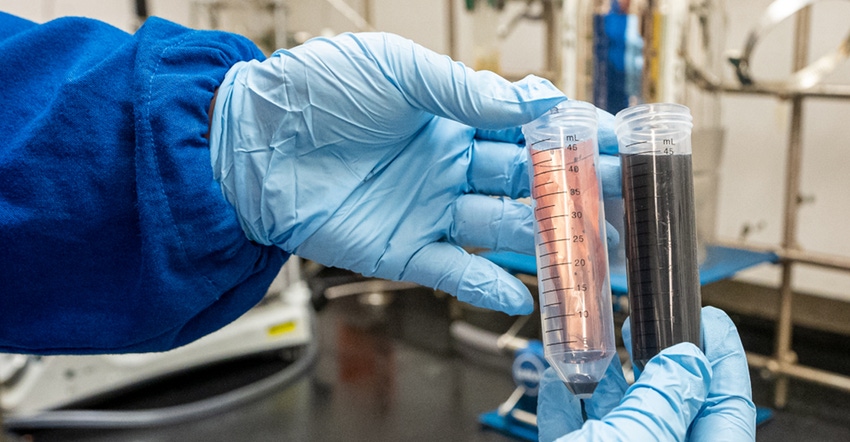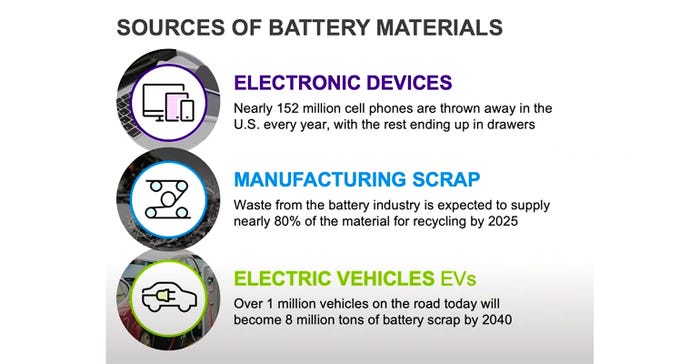Why Recycling is Essential to the Battery Business
Battery materials don’t go away; they just change form—and with battery recycling, those forms remain useful.
February 9, 2023

For many manufactured products, indeed for many of us, life is a linear prospect. Out of selected raw materials, a product is born, undergoes an experience-filled life cycle, and meets an end perhaps as a source for spare parts or occupying space in a landfill.
Contemplate the composition, production, useful life, and re-use potential of batteries and the graphic description becomes not a straight line but more of a circle with neither beginning nor end.
This is so for a number of reasons. Primary among them are chemistry and physics—it’s the way batteries work. The first commercial battery dates back to 1799 and consisted of a copper cathode, a zinc anode, and a salt electrolyte. Electrons moving from the anode to the cathode through the electrolyte convert chemical energy to electrical energy, providing power. Run an external source of direct-current (DC) power through the cell and this moves the electrons back to the anode side, restoring the original composition and recharging the cell. It is the evolving combinations of chemical elements and electrolyte variations that form the news-breaking applications for different battery models, power levels, recharging life, and reuse.
JB Straubel, CEO of Redwood Materials, has billion-dollar battery recycling plants underway in Nevada, supplying Tesla’s gigafactory, and South Carolina, with Volvo and Mercedes-Benz EV manufacturing in the area. In January 2023, he told MIT Technology Review, “Something that isn’t intuitive is just what a high level of reusability metals inside of a battery have. All of those materials we put into a battery and into an EV don’t go anywhere. They’re all still there. They don’t get degraded, they don’t get compromised—99% of those metals, or perhaps more, can be reused again and again and again. Literally hundreds, perhaps thousands of times.”
Battery recycling isn’t easy—but will get easier
Those metals do need to be reprocessed, however, and that isn’t easy. Current battery recycling involves first shredding and grinding batteries into “black mass,” then burning them (pyrometallurgy) or chemically leaching them (hydrometallurgy) to separate the metals from the other constituents. Recycling companies aim to make their processes as efficient as possible, but due to most past and current battery designs, recovering the elements is still expensive, energy-intensive, and involves toxic chemicals that must be carefully managed.

Getting to those valuable and reusable materials may start getting much easier, which also translates into being more affordable. In February 2023, a team of scientists from California’s Lawrence Berkeley National Laboratory (Berkeley Lab) announced a new battery material for making cathodes and anodes called Quick-Release Binder. It consists of two commercially available polymers, polyacrylic acid (PAA) and polyethylenimine (PEI), joined together through positively charged nitrogen atoms in PEI bonding with negatively charged oxygen atoms in PAA. Placing the solid binder material in alkaline water containing sodium hydroxide (Na+OH–), breaks the bond. The now-separated polymers dissolve into the liquid, freeing any electrode components embedded within for straightforward filtering, air drying, and reuse.
Not only can Quick-Release Binder be used for making electrodes, but it is also about one-tenth the price of two of the most commonly used commercial binders, according to Berkeley Lab. “[In our recent research] we demonstrated that the whole process is very easy at lab scale and we see no reason why it won’t work equally well at industrial scale,” says Chen Fang, post-doctoral researcher at Berkley Labs’s Energy Storage and Distributed Resources Division. He added the team believes the material can be used for batteries of all sizes, from pouch cells for tablets and cell phones to the extra-large batteries being deployed for grid storage.
Physics and chemistry breakthroughs aside, authorities agree recycling efforts need to be stepped up on an orders-of-magnitude basis. ReCell, a consortium of national labs and leading technological universities supported by the Department of Energy’s Vehicle Technologies office, is concentrating research on more efficient direct material recycling as well as advanced resource recovery.
“Improving the economics of battery recycling will help incentivize those with batteries to bring them in for recycling instead of throwing them out,” ReCell says. “This will help increase collection rates and lower raw material costs so future batteries are even more affordable.”
Editor’s Note: This is the 5th in our series on the Brave New World of Battery Manufacturing. The Brave New Battery World. Read Part 1 on the Federal Consortium for Advanced Batteries Roadmap and investment issues; Part 2 on Current Research; Part 3 on Boom-Time Battery Production; and Part 4 on Battery Materials’ Scarcities and High Prices. And watch for further installments, coming soon.
About the Author(s)
You May Also Like



.jpg?width=300&auto=webp&quality=80&disable=upscale)

